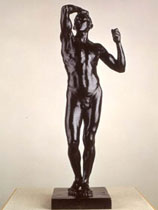The Franco-Prussian War broke out in 1870. The 30-year-old Rodin was drafted into the National Guard but was soon discharged because of his nearsightedness. Finding himself without work, he accepted a job with Albert-Ernest Carrier-Belleuse, a fashionable sculptor for whom Rodin had worked earlier. Carrier-Belleuse had the commission to provide sculptural decoration for the new stock exchange building in Brussels. Rodin went there alone, leaving Rose and their son behind in Paris. His stay in Belgium lasted six years and proved to be a creative and inspirational time for him. Here he held his first exhibition, making his debut as an independent sculptor.
 In 1875, after an inspiring trip to Italy to see the work of Michelangelo, Rodin began work on a large figure intended for submission to the Paris Salon. Again, he modeled from life. The life-size male nude, first titled The Vanquished, showed the influence of classical sculpture but was modeled in a more naturalistic way, without the emphasized musculature that Greek and Roman sculptors often used. He first presented The Vanquished in Brussels. Here some critics were suspicious of the piece’s remarkable realism and accused Rodin of making a mold from a live model. Rodin defended himself against the accusation, but to little avail. He returned to Paris, but the rumors followed him when he submitted the nude, now titled The Age of Bronze, to the Paris Salon of 1877. It was praised for its beauty, but Rodin was again forced to defend himself against allegations of casting from a live model.
In 1875, after an inspiring trip to Italy to see the work of Michelangelo, Rodin began work on a large figure intended for submission to the Paris Salon. Again, he modeled from life. The life-size male nude, first titled The Vanquished, showed the influence of classical sculpture but was modeled in a more naturalistic way, without the emphasized musculature that Greek and Roman sculptors often used. He first presented The Vanquished in Brussels. Here some critics were suspicious of the piece’s remarkable realism and accused Rodin of making a mold from a live model. Rodin defended himself against the accusation, but to little avail. He returned to Paris, but the rumors followed him when he submitted the nude, now titled The Age of Bronze, to the Paris Salon of 1877. It was praised for its beauty, but Rodin was again forced to defend himself against allegations of casting from a live model.
 Now back in Paris, Rodin supplemented his income by working for the Sèvres porcelain factory, again with Carrier-Belleuse. It was also during this time that Rodin created one of his most powerful figures, Saint John the Baptist Preaching, which would be exhibited with The Age of Bronze in 1880. Partly to exonerate himself from earlier allegations, Rodin made his figure of John larger than life-size. However Rodin still created a stir among critics, this time for his uncommon portrayal of the Saint. Rodin’s St. John did not include his common attributes – a hairshirt, leather belt, cross, and scroll – but instead presented a non-idealized nude that his contemporaries found improper, ugly, even shocking.
Now back in Paris, Rodin supplemented his income by working for the Sèvres porcelain factory, again with Carrier-Belleuse. It was also during this time that Rodin created one of his most powerful figures, Saint John the Baptist Preaching, which would be exhibited with The Age of Bronze in 1880. Partly to exonerate himself from earlier allegations, Rodin made his figure of John larger than life-size. However Rodin still created a stir among critics, this time for his uncommon portrayal of the Saint. Rodin’s St. John did not include his common attributes – a hairshirt, leather belt, cross, and scroll – but instead presented a non-idealized nude that his contemporaries found improper, ugly, even shocking.